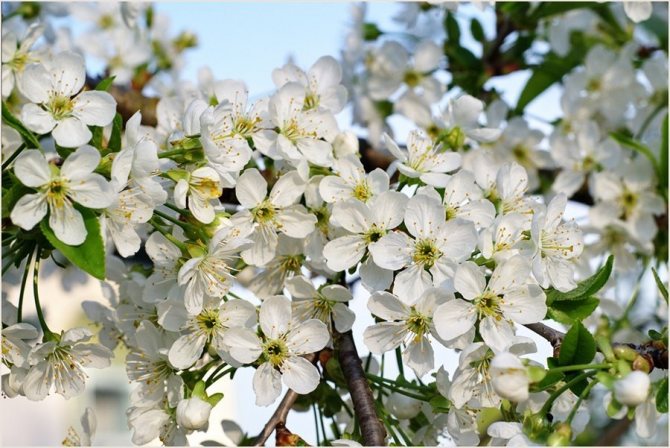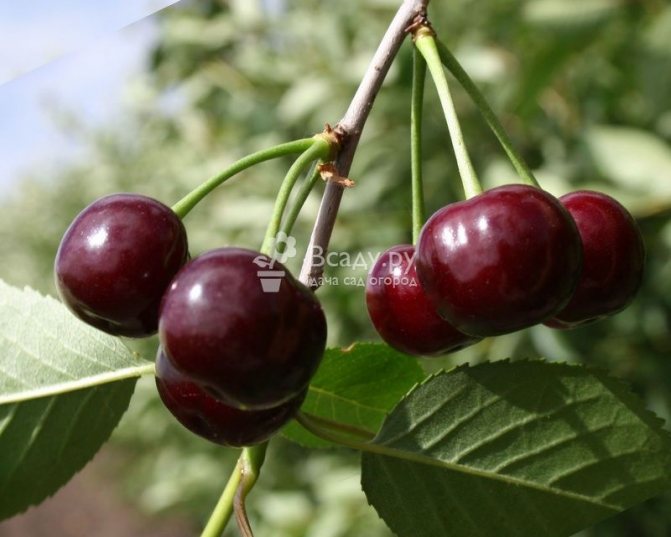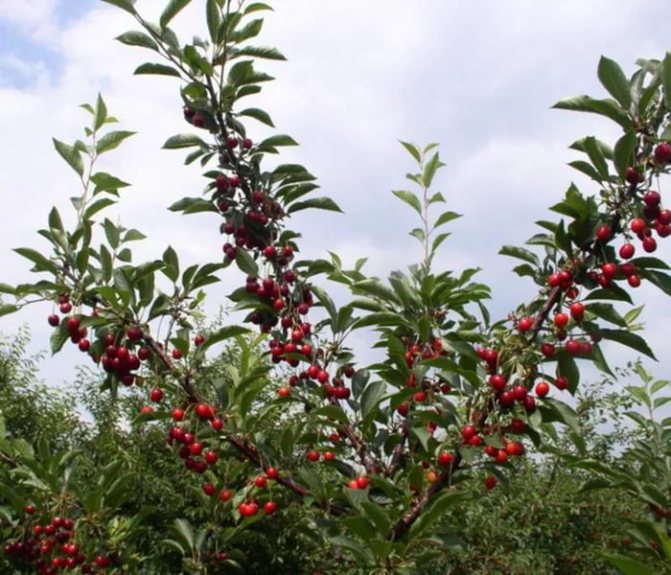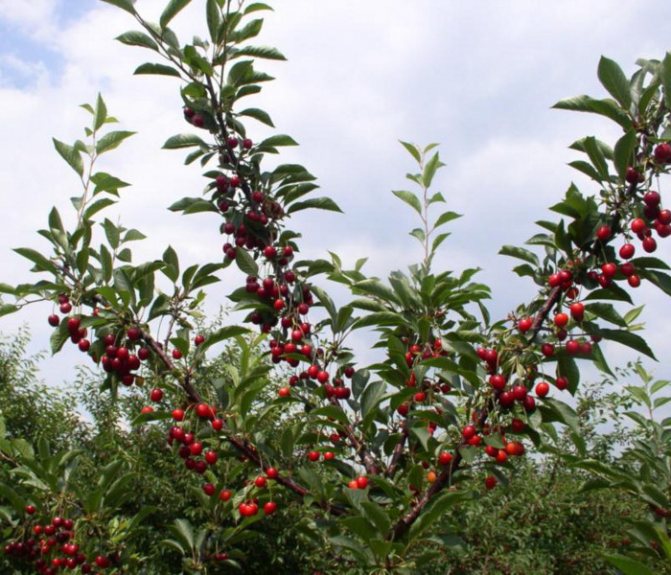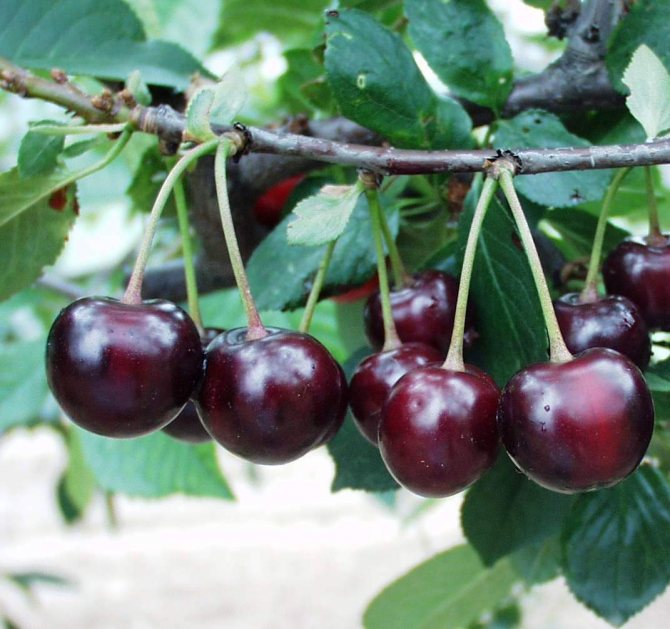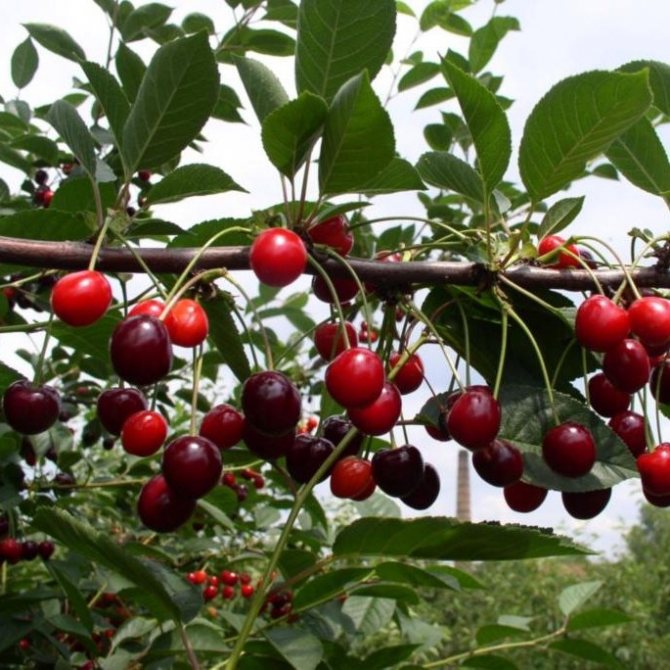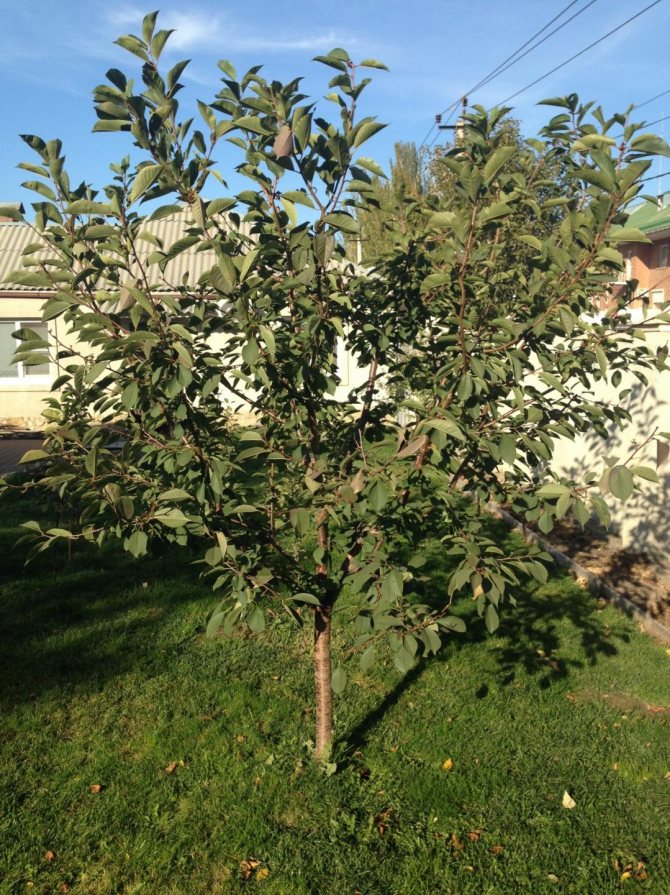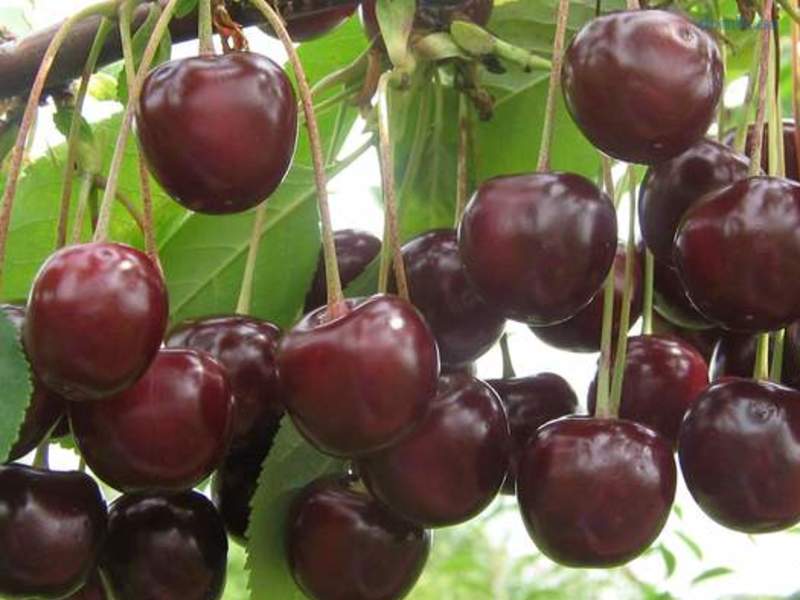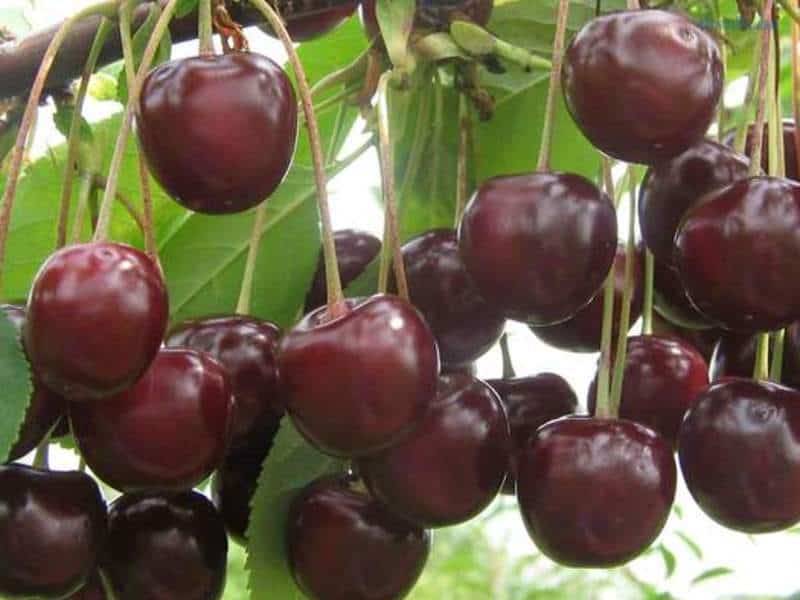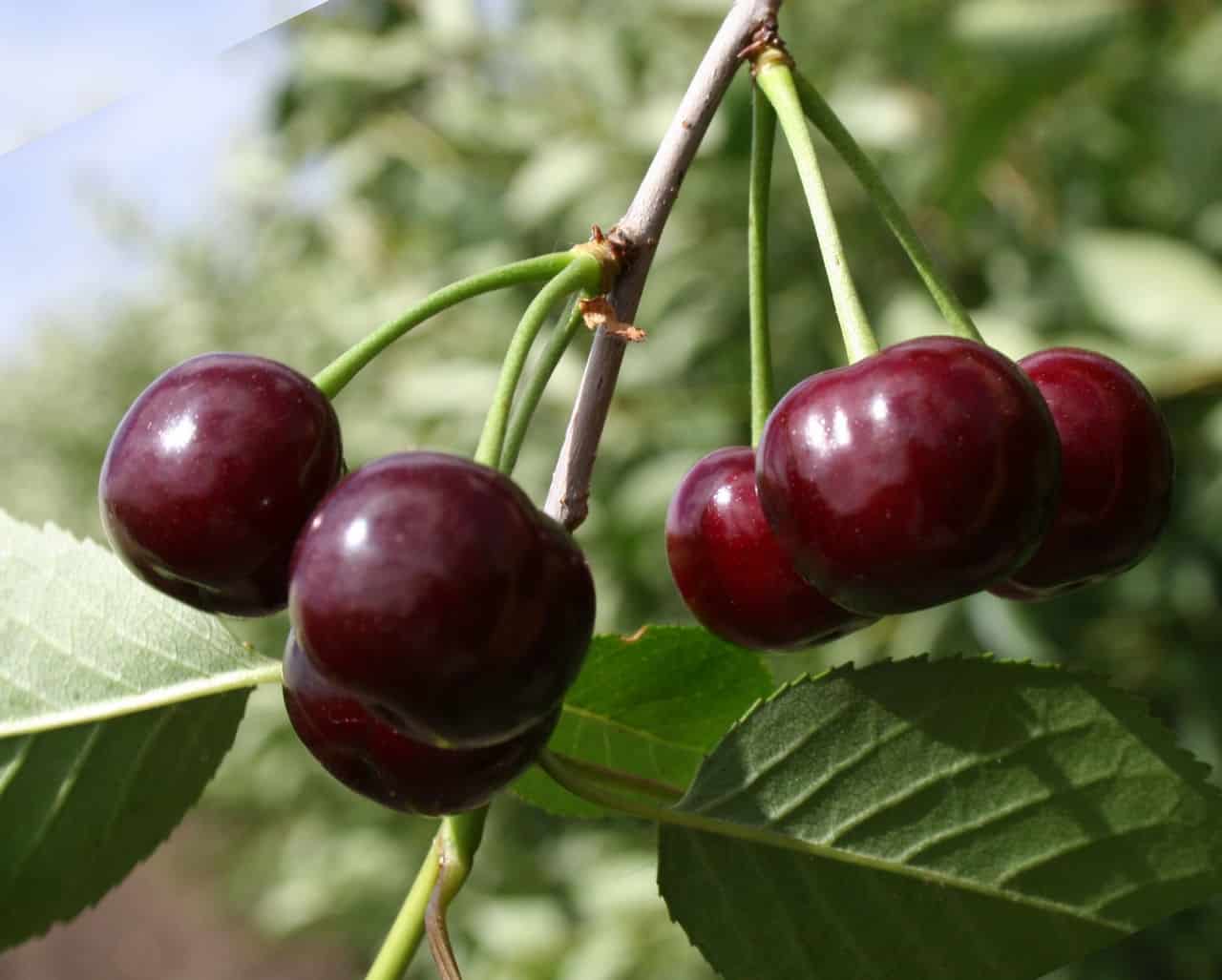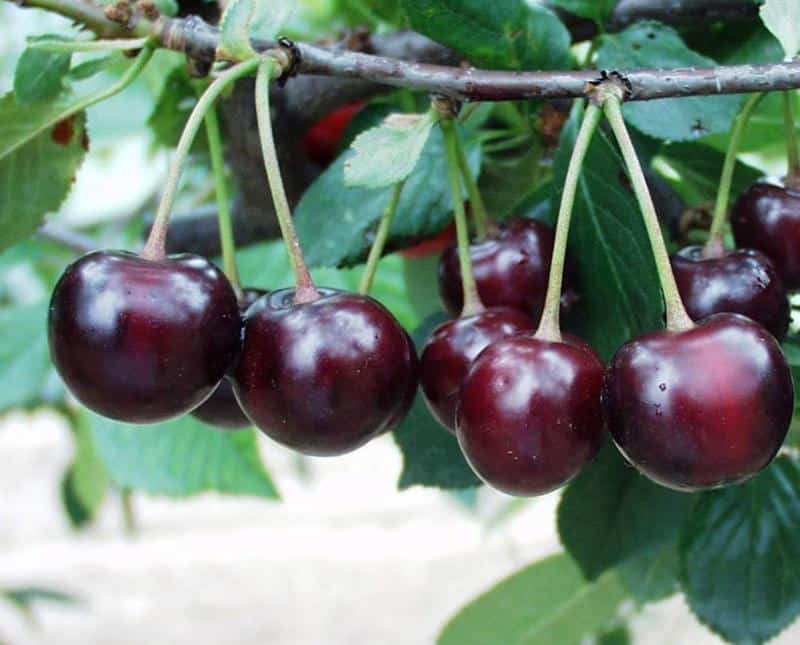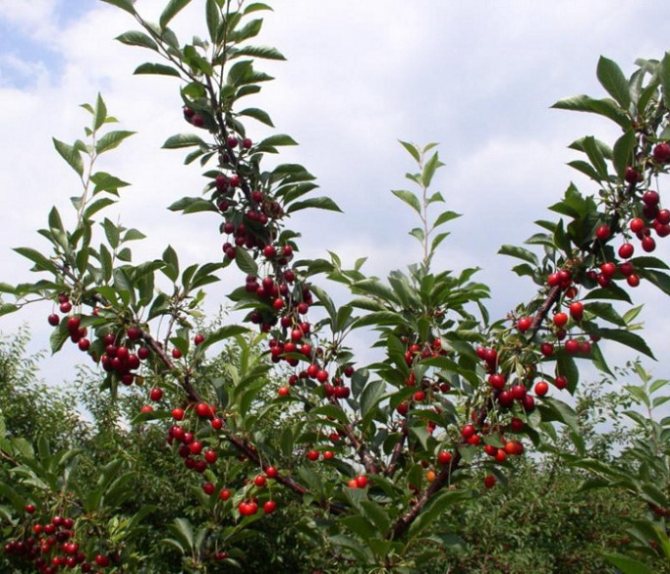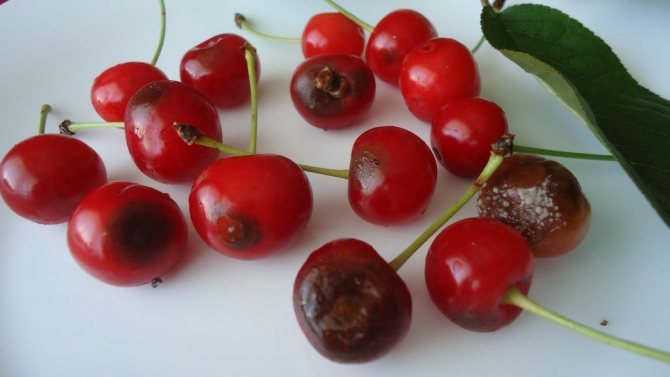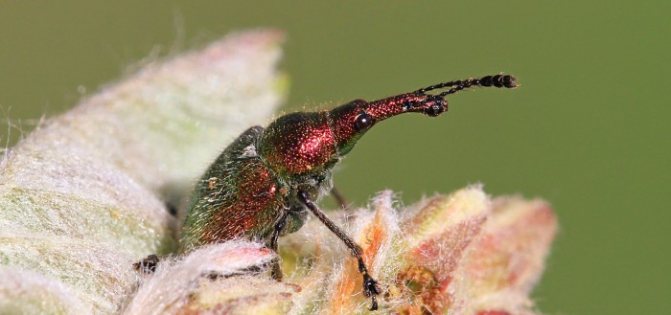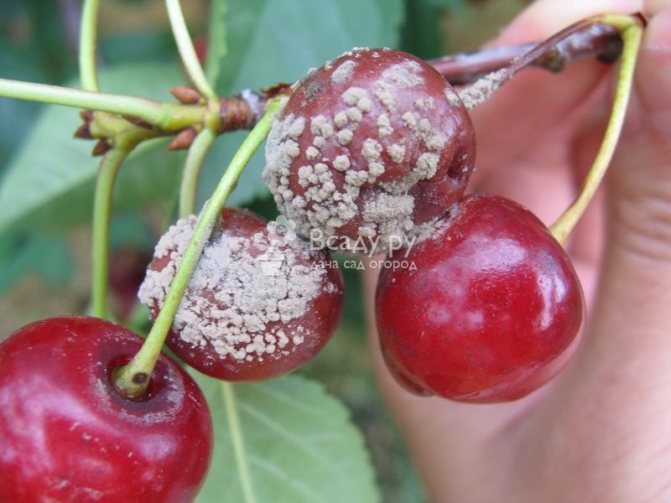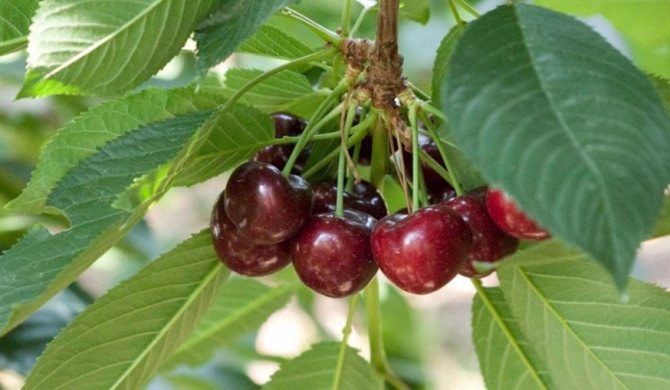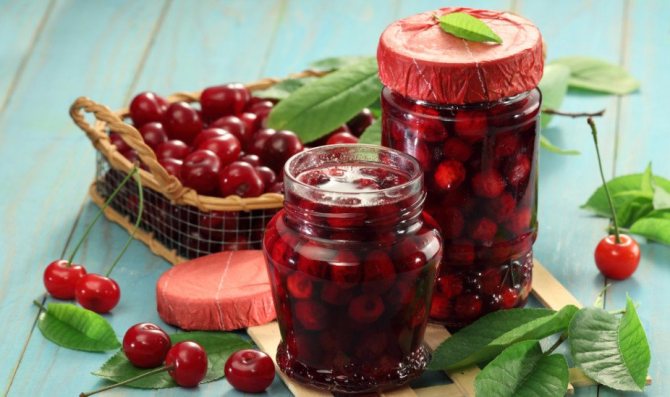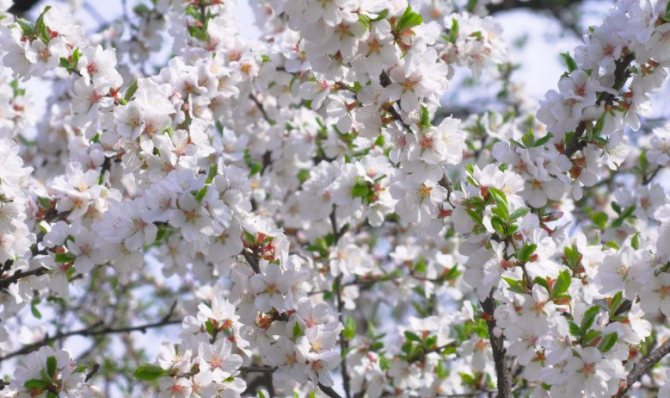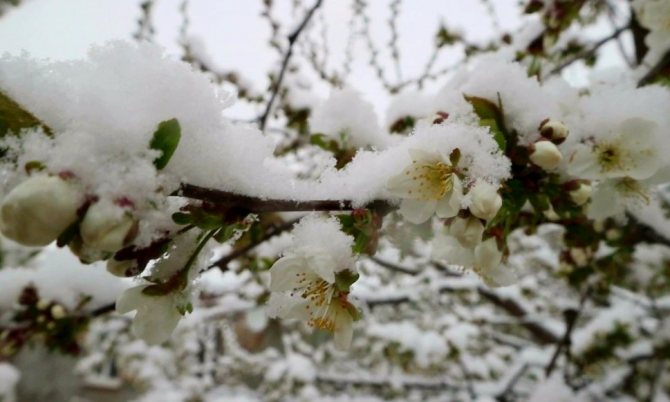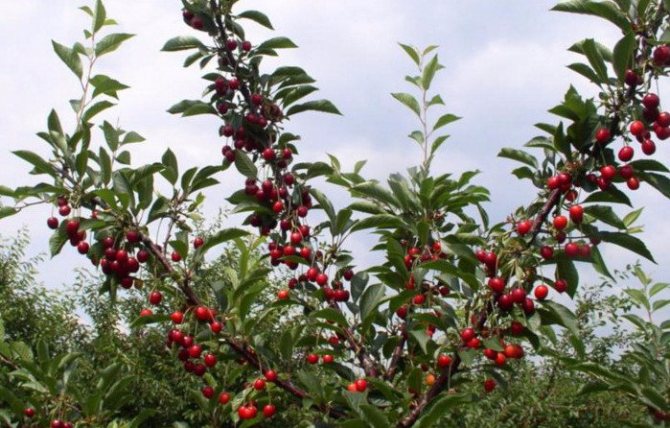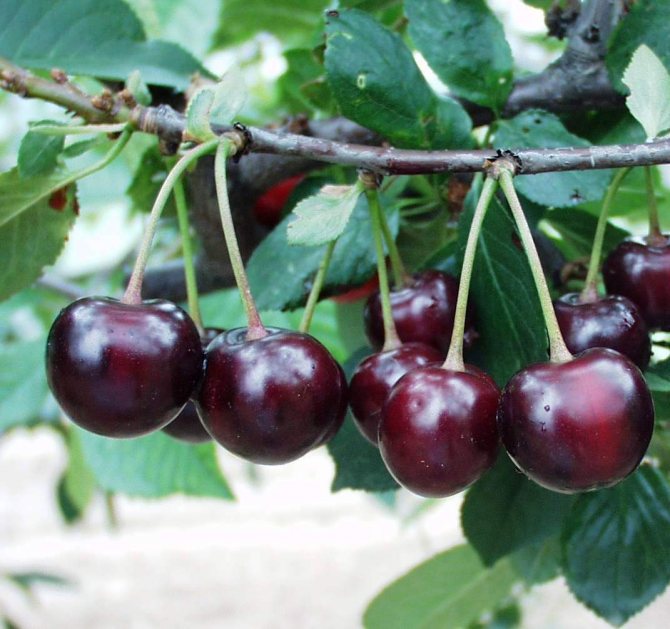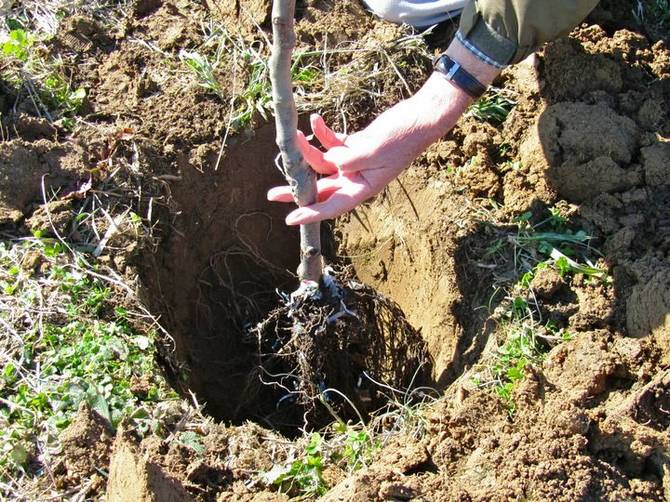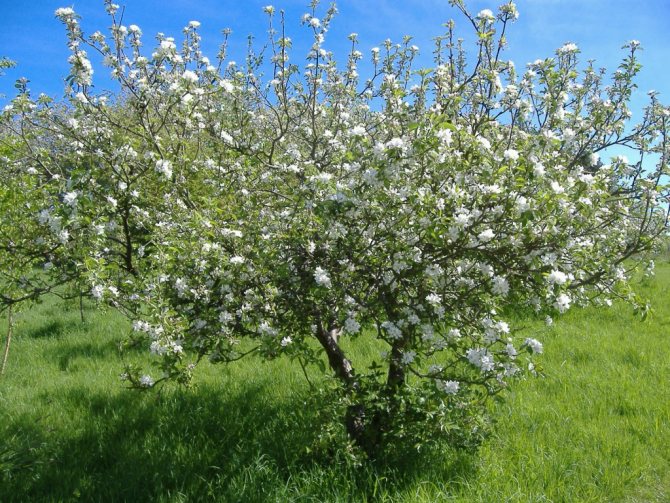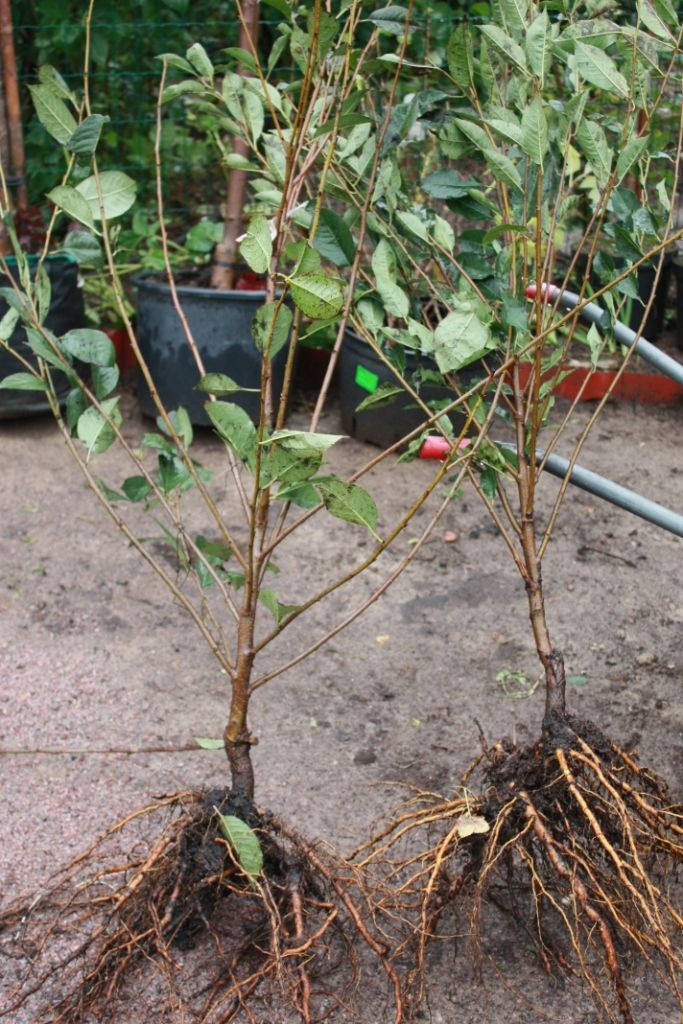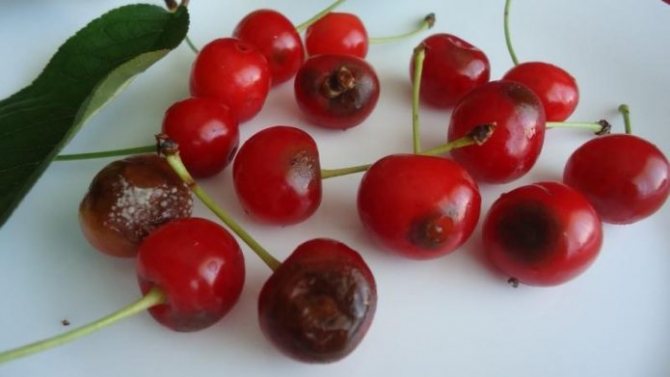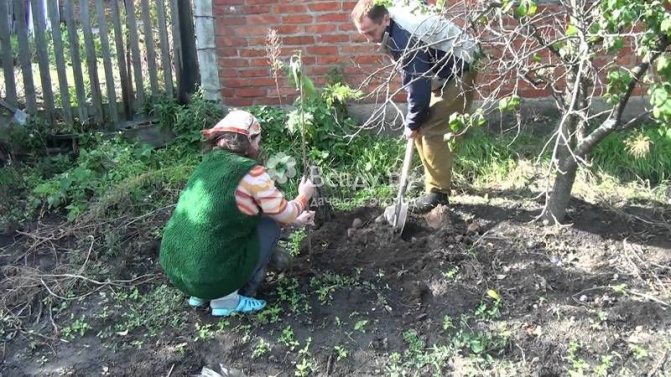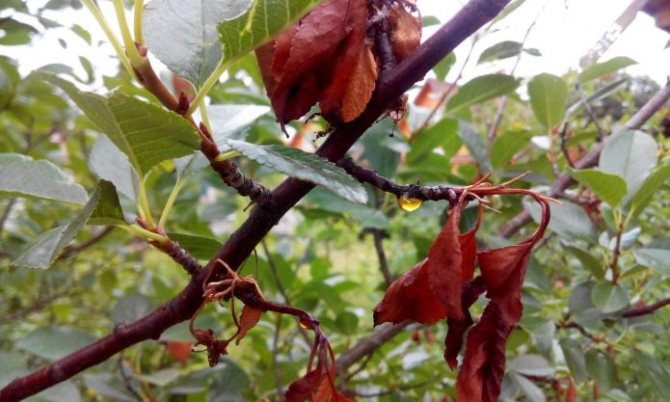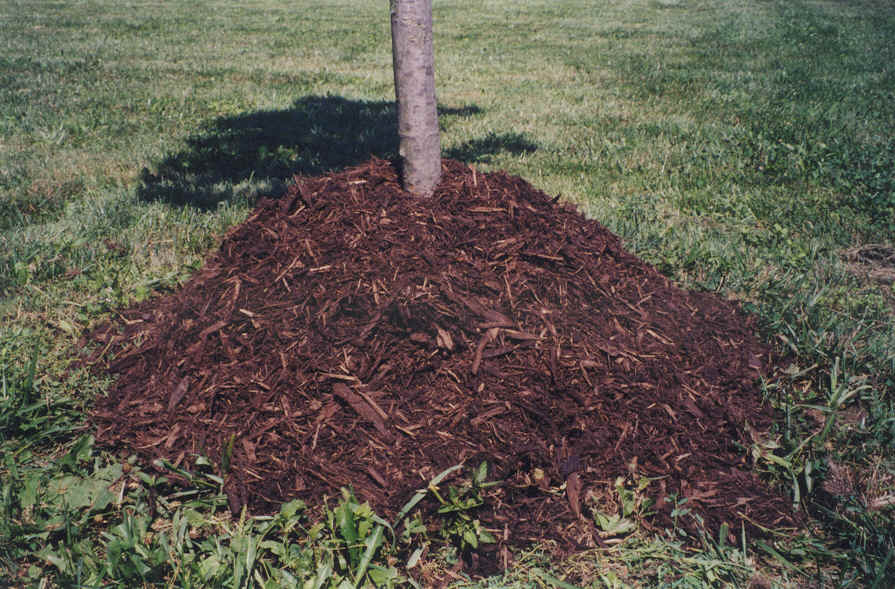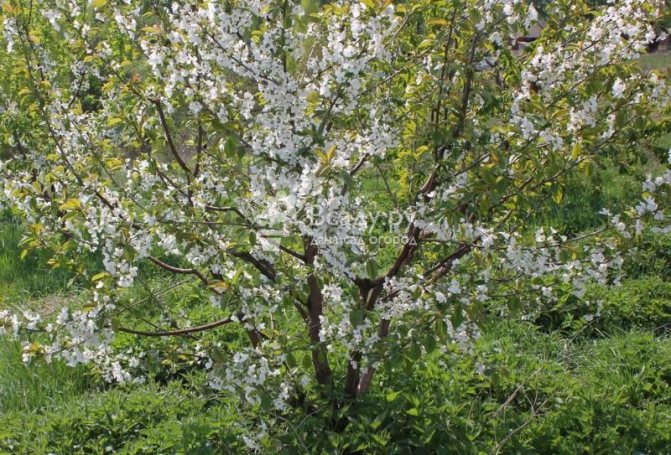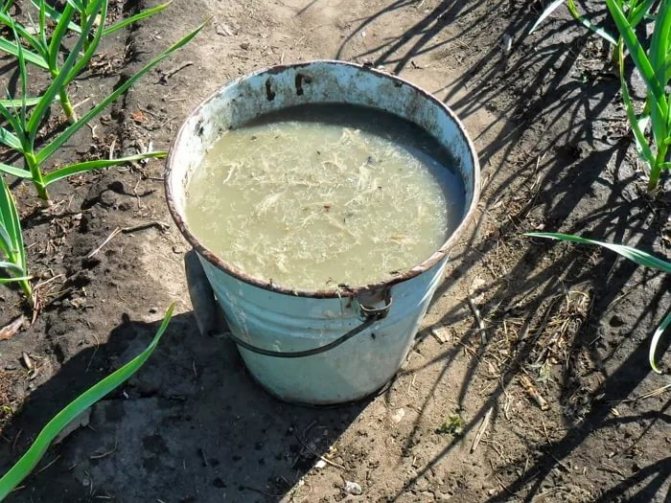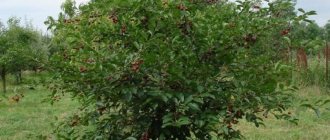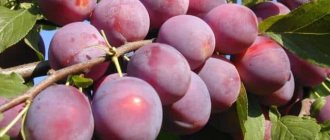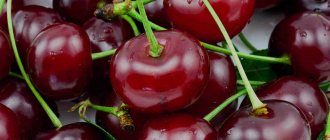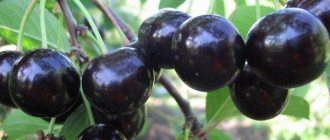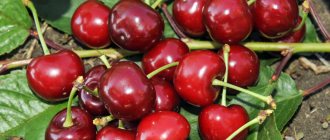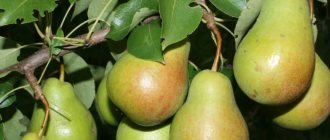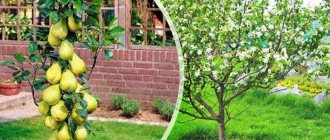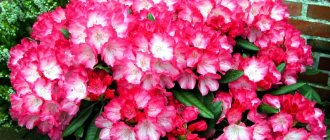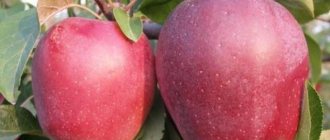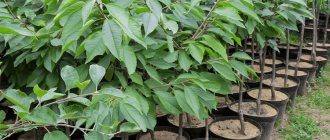Advantages and disadvantages
Cherry Morozovka has its own advantages and disadvantages. The positive aspects include:
- high resistance to frost;
- regular and stable harvest;
- disease resistance;
- grows well in drought;
- tree growth up to 2.5 m, which is easy and quick to harvest;
- transportability of berries;
- high taste of fruits.
Of the shortcomings, self-infertility is noted. For fruit ovary, the presence of a pollinator is required, the flowering period of which must coincide with the cherry.
Description of culture
Freezer forms a small tree, which usually does not grow taller than 2.5 m. Raised strong branches form a wide crown of medium density. On the trunk and old shoots, the bark is light brown. Young branches are grayish green.
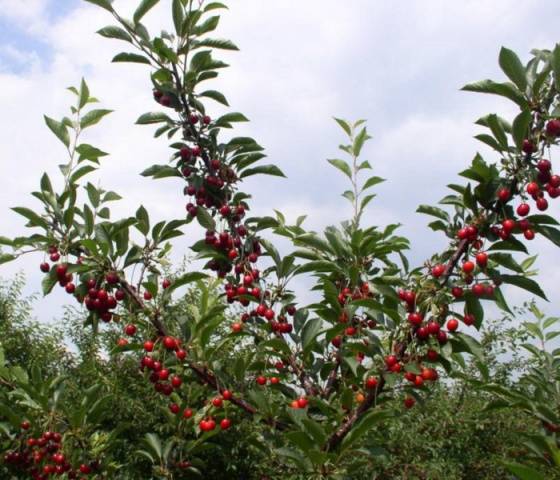
Serrated green leaves of cherry Morozovka are oval, strongly elongated, of medium size. The petiole is long, anthocyanin-colored.
White flowers are large, with rounded petals. Morozovka, like the parent variety Vladimirskaya, belongs to griots - cherries with dark red berries, pulp and juice. Fruit weight - about 5 g, taste - dessert, sweet, with barely perceptible sourness. The shape of the berry is round, the abdominal suture is hardly noticeable, the integumentary points are absent. The flesh of the Morozovka cherries is dense, with a lot of juice. Medium oval seed, it separates well from the berry. Most of the fruits are tied on bouquet branches, much less on annual growth.
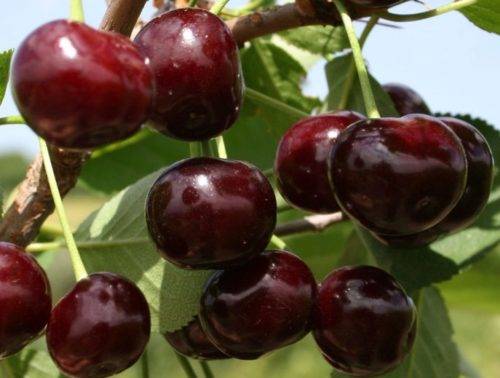

Cherry Morozovka is successfully grown in the North-West, Central, Lower Volga, Middle Volga, North Caucasian and Central Black Earth regions.
Brief characteristic of the variety
The description of the variety includes yield, fruiting, pollination, flowering, ripening, and immunity features.
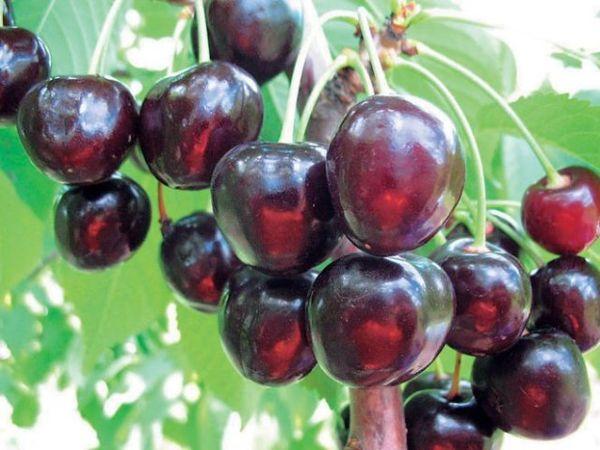

Productivity, fruiting
The variety gives high yields in the presence of pollinators. Without them, the plant blooms, but does not form ovaries. Fruit formation begins in mid-July and ends by the end of the season. On the shoots, large berries are formed, weighing up to 5 g, of a dark burgundy color. More than 35 kg of berries are harvested from one tree.
Pollination, flowering period and ripening times
Pollinators are required for fruiting. For this variety, the simultaneous presence of 2 - 3 trees is recommended. In such conditions, cherries will give a stable and high yield. The following varieties are suitable for pollination:
- Zhukovskaya;
- Vladimirskaya;
- Turgenevka;
- Lebedyanskaya;
- Griot Michurinsky.
Important! The presence of several pollinators increases the productivity of the Frostbite.
Scope of berries
Cherry Morozovka is grown for industrial purposes and in their own gardens. The berries are sweet, suitable for fresh consumption. Also, the harvest is processed into compotes, jams, homemade wine, liqueurs, tinctures, and frozen. This variety sells well, it is grown for sale, on large farms and enterprises.
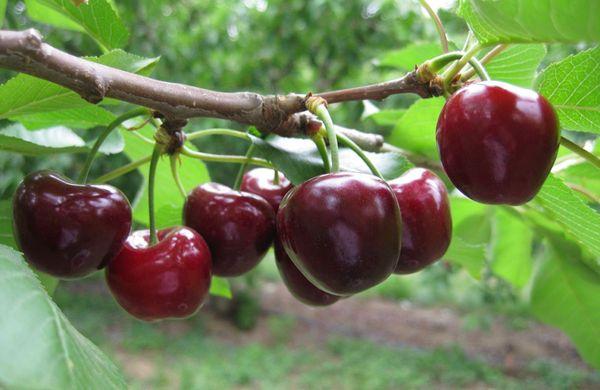

Frost and drought resistant
The tree is highly resistant to frost. It tolerates temperatures below -35 ° C. A strong root system feeds the plant from groundwater, which helps to cope with drought and allows less attention to watering.
Immunity to diseases and pests
Freezer has a strong immunity to coccomycosis.However, it is susceptible to other diseases that need to be combated and prevented. Diseases characteristic of cherries:
- rust;
- bacterial burn;
- sooty fungus;
- fruit rot;
- perforated spotting;
- gum flow.
When affected by fungi, the foliage is sprayed with fungicidal preparations. Pre-remove damaged areas.
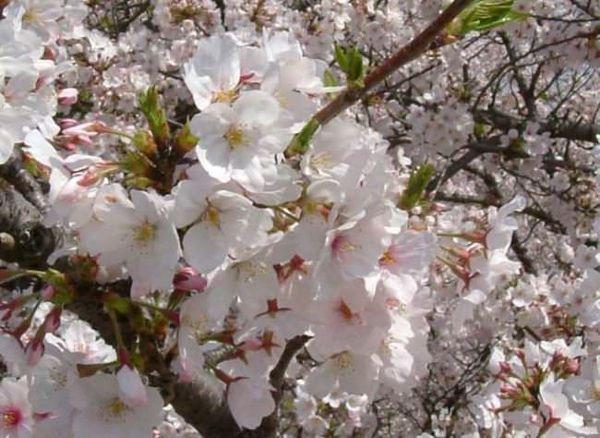

Insects attack cherries more harmful. They feed on the fruits, bark and foliage of the tree. These include:
- aphids;
- cherry moth;
- piper;
- ringed silkworm;
- hawthorn.
See also
How to permanently get rid of cherry overgrowth on a plot with your own hands
To read
Insects die after insecticide treatment. The procedure is carried out 2 - 3 times per season.
Important! Spraying with chemicals is stopped 20 days before harvest.
Pests
When growing cherries, it is necessary to pay serious attention to pests that damage trees and crops.
Table: cherry pests
| Pest | Description | Control measures |
| Cherry weevil | Bugs up to 5 mm in size, golden-burgundy. Starting from spring, they eat buds, leaves, flowers, ovary. They lay eggs inside the berries. After 2 weeks, the larvae appear and eat the cherries until autumn, when they go into the soil and pupate. | Fufanon-Nova, 12 milliliters per 10 liters of water. Consumption: 5 liters per mature tree. Spray during the growing season. Repeat treatment if necessary. |
| Slimy sawfly | The larvae, similar to black slugs, eat away the tissues of the upper part of the leaf. After them, the leaves look burnt, dry out. In autumn, the larvae go into the ground, and in the spring they fly out as adult flies. | Same |
| Cherry aphid | It feeds on the juices of leaves and young shoots. Can cover leaves and shoots with a dense carpet. | Treatment with Intavir and Aktofit according to the instructions. |
Cherry pests - photo
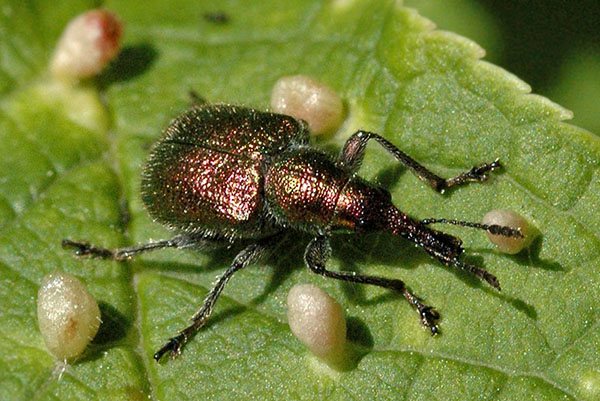

Cherry weevil eats buds, flowers, fruits
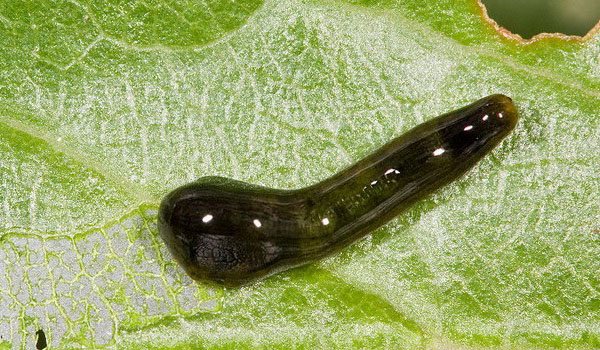

A slimy sawfly can destroy a significant part of the foliage.
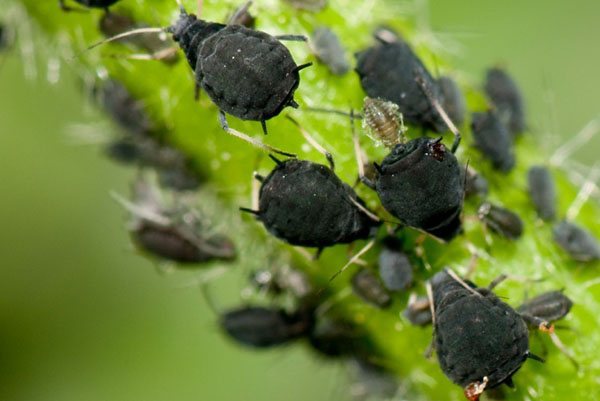

Aphids cause serious damage to cherry trees by eating leaves
Necessary conditions for growing
To obtain a high yield, you need to create optimal conditions for growing a crop. Correctly selected place and soil composition provide cherries with everything necessary for good development.
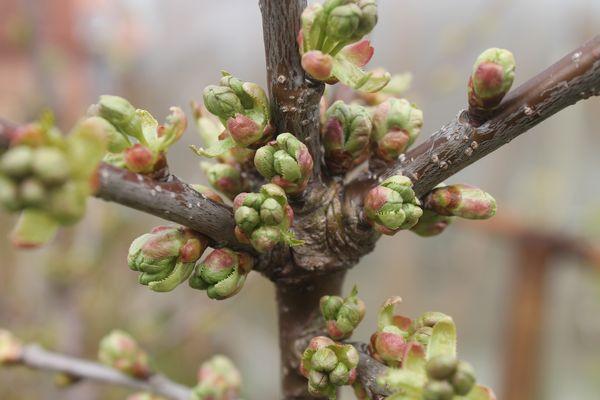

Climate and landing regions
Any region is suitable for growing cherries. Its high resistance to frost and early maturity of fruits allows it to be planted in Siberia, the Urals, in temperate latitudes and in the south. In the southern regions, the fruits are ready for harvest in the middle of summer. For the north, most varieties of cherries are not suitable, as they can hardly endure winter frosts. Freezing allows you to keep cherries in your own garden and enjoy their fruits.
Soil composition
The plant is not picky about the composition of the soil. Loamy, sandy loam and sandy soils are suitable for planting. On clayey soils, drainage is laid in the planting pit to ensure the outflow of excess moisture. The acidity of the earth should be neutral. Before transferring to open ground, top dressing is carried out.
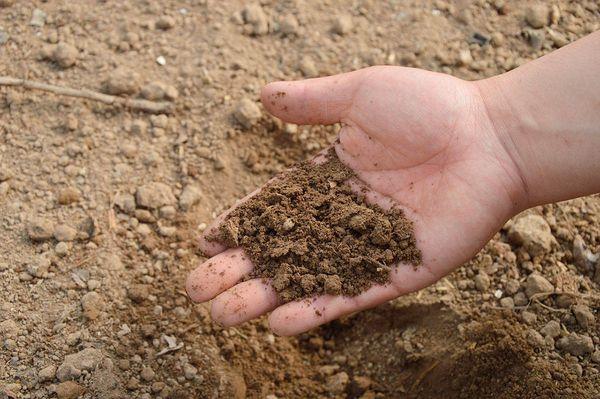

Favorable and unwanted neighbors
Cherries are planted next to other varieties of the crop. The neighborhood with apple trees, plums and peaches also develops favorably. Do not plant Morozovka next to bushes. Their roots extend to the side and take food from the tree.
Cherry Morozovka variety description
Freezer grows into a tree of medium height (about 2.5 m). Its crown is raised, wide and rounded. The bark of the trunk and branches of the cherry is light, brown. Shoots are light green and large with oval buds.
The leaves of this variety are small in size, have an oval shape and a bright smooth surface with a green tint. There are small reddish glands at their bases. Leaves are attached to a long handle.Large Morozovka flowers are horn-shaped and have round petals.
Cherry Morozovka variety description
Cherry fruits begin to ripen from July to the third or fourth year of the plant's life. They are characterized by massive size (about 5 grams), bright color and round shape, with a depression. Inside the fruit there is an oval-shaped bone, which is easily separated from the pulp.
Dark red, almost burgundy, the fruit pulp is dense, juicy and slightly sour, due to which it is ranked among the dessert varieties. Cherry does not lose its freshness of taste even after cooking. As for the chemical composition, besides sugar (10.5%), it contains macro and microelements, ascorbic and folic acids, as well as pectins.
Read also: Carrot Bolero F1: description, photo, reviews
Landing technology
Plants are planted according to a specific algorithm. It is necessary to take into account the place, prepare a planting hole and a seedling in advance.
Site selection
For cherry growth, sunny areas, sheltered from the wind, are suitable. Access to sunlight should be at least 8 hours a day. Places are chosen where groundwater is at least 1.5 m.If they are higher, then the culture will experience an excess of moisture.
Preparing the planting pit and seedling
The landing pit is prepared in advance. When planting in the spring, work is carried out in the fall, in the spring - 2 weeks before transfer to the ground. The procedure is carried out as follows:
- Dig a hole with a depth and diameter of about 1 m;
- The earth from the hole is mixed with humus, superphosphate and potassium nitrate;
- Half of the mixture is poured back into the pit.
The seedling is soaked in water for several hours before planting. Only then are they transferred to the hole.
Important! Do not leave the roots of the plant unmoistened, they can dry out.
Tree planting algorithm
Planting a seedling is carried out according to a certain algorithm:
- The tree is placed in the hole;
- Spread the roots;
- Sprinkle with earth in layers;
- Each layer is tamped by hand;
- Form a near-trunk circle with a depth of 8 - 10 cm;
- Water with 4 - 6 buckets of water;
- The area near the trunk is mulched with straw, sawdust, and cut grass.
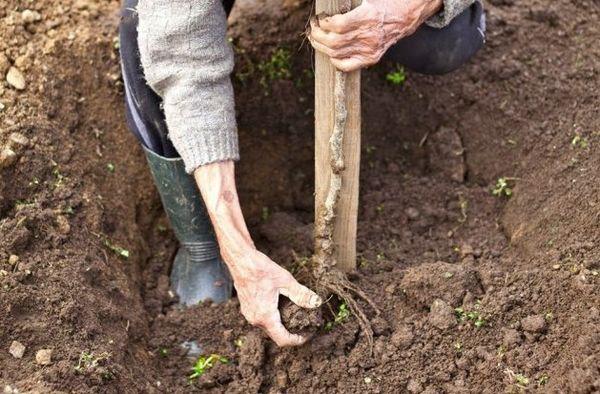

Cherry Morozovka reviews, planting and care
According to the reviews of experienced gardeners and ordinary lovers, cherries of this variety are quite easy to care for and do not need a special approach.
The key to the correct development of cherries is planting. To do this, you need to choose fresh, well-fertilized soil. It is desirable to carry out its aeration and scarification. Suitable soils with neutral acidity, sandy, loamy drained and sandy loam.
When choosing a place, keep in mind that the root system of the plant does not like an abundance of moisture. Cherry likes good light and does not tolerate strong winds, so you need to plant it in a sunny place, well protected from drafts.
For the winter, the trunk and branches of young trees are covered with dense material (agrofibre can be used) so that rodents do not damage the seedlings.
Secrets of successful planting of seedlings
- The distance between plants is 2.5 - 3.5 m.
- The size of the landing pit is 45cm deep, 60cm in diameter.
- The soil from the pit is mixed with humus (1: 1); ash (1kg), superphosphate (40g), potassium chloride (25g). One and a half buckets of sand are added to the clay soil.
- Pour two or three buckets of warm water over the cherries. The soil is mulched with sawdust and humus, forming a protective layer that protects the soil from drying out.
Basic care for Frosting includes:
- Periodic watering (soil moistening without oversaturation);
- Pruning branches up to 50 cm in length (in spring before the buds swell);
- Pest control with Kinmix and Fumanon;
- Application of fertilizers used for planting (when the color of the leaves changes, poor fruiting).
Cherry Morozovka is an excellent variety that, if properly planted and adhered to all standards of care, will delight you with an abundant harvest of tasty and healthy berries.
Care rules
To get a high yield, it is necessary to create optimal growing conditions. For this, the plant is watered, fed, pruned, protected from rodents and birds, pruned and covered for the winter.
Irrigation
Cherries tolerate drought well. Additional water increases the number of fruits and strengthens the plant's immunity. There are three required watering during the season:
- before the onset of kidney formation;
- during flowering;
- after harvest.
See also
Description of cherry varieties Zhukovskaya, planting and care in the open field
To read
A young tree consumes 50 - 60 liters at a time, fruiting 70 - 80 liters. The liquid is poured into the area of the trunk circle.
Important! Waterlogging of the tree leads to the formation of root rot and death.
Top dressing
After planting, the tree has enough nutrients for 3 years. Then, annually, mineral dressings with the content of potassium, phosphorus and nitrogen are introduced. In the spring, urea and copper sulfate are used. From the seventh year of the growing season, feeding is carried out 1 time in 2 years.
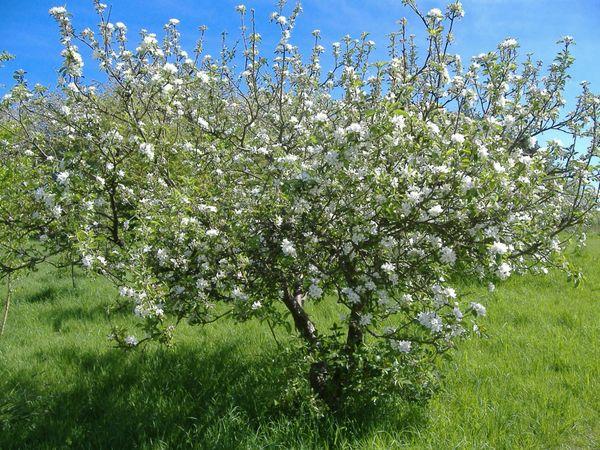

Loosening and hilling
Loosening and weeding are combined. The procedure is done as the weeds grow in the near-trunk circle. Hilling is carried out 3 times per season: before bud formation, during flowering, during fruiting. Sprinkle the trunk to a height of 20 cm. This will keep moisture at the roots of the tree.
Crown pruning
Formative pruning is done for the first 3 years. Morozovka is characterized by spherical branching. In the following years, damaged, broken and dry branches are cut off. The procedure is carried out in the spring for crown formation and in the fall for sanitation. Pruning improves the quality of the tree, increases yields, and prevents fungal infections and rot development.
Seasonal treatments
In the spring, it is recommended to do the prevention of diseases and insect attacks. For this, spraying with insecticides and fungicides is carried out. The procedure is repeated 3 times per season. The frequency depends on the age of the chemical. As soon as it expires, the spraying is repeated.
Copper sulfate is also added in the area of the trunk circle. It destroys harmful insects that live under the bark and in the roots of cherries.
Protection from birds and rodents
To protect against rodents at the beginning of the season and before winter, the trunk is smeared with whitewash. This scares the animals away and prevents them from feeding on the bark.
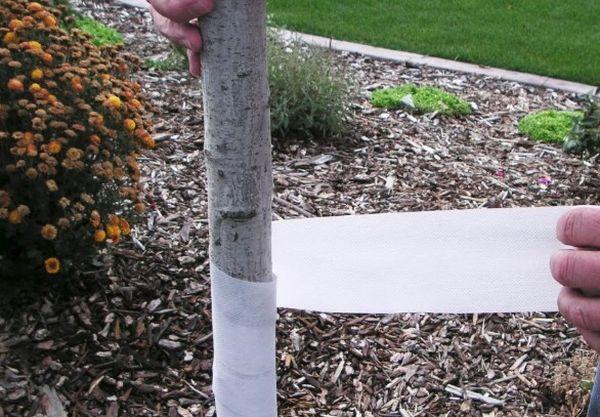

Birds eat up part of the crop. They need to be scared away, used for this purpose:
- cellophane;
- cassette tape;
- sound frequency devices;
- mesh with wide openings.
All these devices are hung on the branches.
Preparing for winter
The tree is highly resistant to frost. To be sure that it recovers in the spring, it is recommended that you cover it for the winter. For adults and young trees, the trunk circle is mulched with the help of:
- straw;
- sawdust;
- cut grass;
- moss.
Important! The seedlings are sheltered for the winter using breathable fabrics. Their resistance to frost is maximally manifested by the third year of life.
Harvesting
Cherries are harvested in dry weather. Cherry varieties Morozovka are best suited for fresh consumption, as well as for harvesting.
Jam, juice, various desserts, kvass, liqueur are prepared from it, used as a filling for baking.
There is an interesting way to store cherries. In a clean glass jar, layers of clean, dry fresh cherry leaves are stacked, shifting them with berries. The top layer should be leaves. The jar is closed with a plastic lid and placed in a cool place. The berries are stored until winter.
How to properly plant a cherry sapling
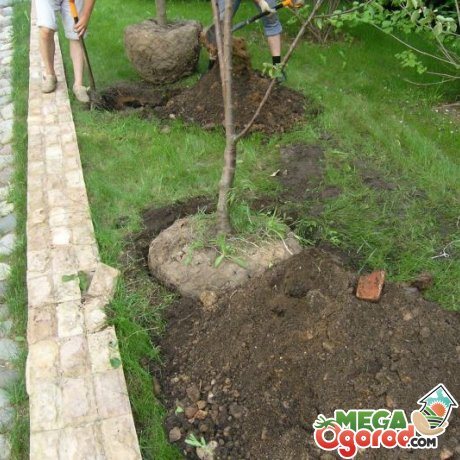

The culture is planted with the onset of spring. Young cherries harvested since autumn are added dropwise. The root system of the plant is insensitive to the proximity of groundwater, which makes it possible to cultivate cherries on different soils.
Since the seedling is not afraid of winter, it is successfully grown in the warm and northern regions of the country. It does not need additional insulation.
Cherry Frost will feel great in a protected from drafts, illuminated place. Suitable soil of neutral acidity, sandy, sandy loam or loamy drained.
Secrets of planting a seedling:
- The distance between the planted plants is from 2.5 to 3.5 m.
- The optimal size of the planting pit is 40-45 cm in depth, 50-60 cm in diameter.
- The soil from the pit is combined with humus (1: 1), potassium chloride (20-25 g), superphosphate (30-40 g), ash (1 kg). In heavy clay soil, it is recommended to add 1.5 buckets of sand.
- Having planted a tree, a small earthen rampart is formed at a distance of 25-30 cm from the trunk. Its role is to create a watering hole.
- The seedling is watered with 2-3 buckets of warm water. The earth will settle noticeably after the liquid is absorbed. The area around the trunk is mulched with sawdust and humus. A protective layer (2-3 cm) is formed, which will protect the soil from strong evaporation of moisture and drying out.
The correct planting of Morozovka cherries is the key to its future successful development.
Top pollinators
"Morozovka" is a non-self-fertile variety, that is, trees are not fertilized by self-pollination of flowers. Therefore, in the vicinity of this cherry, self-fertile varieties need to be planted. This feature of "Morozovskaya" is rather an advantage than a disadvantage. The yield of the variety practically does not depend on climatic conditions, because pollination of flowers occurs even in cool spring, when there are still no bees - natural pollinators of plants. Cherry varieties "Griot", "Michurinskaya", "Zhukovskaya", "Lebedyanskaya" are ideal pollinators for "Morozovka", perfectly replacing these hardworking insects.
Planting of seedlings is standard. The plant is fixed in a pre-prepared hole, the rhizome is straightened and sprinkled with soil, then compacted well. The trunk is not tightly attached to the post. An irrigation hole is made around the tree, you can immediately pour it with two buckets of water, the liquid will come off, and the neck of the roots will remain slightly above ground level. Use an effective process for protecting and improving young trees such as mulching 3–4 cm high. Mulch can contain compost, sawdust and humus.
"Kinmiksom"
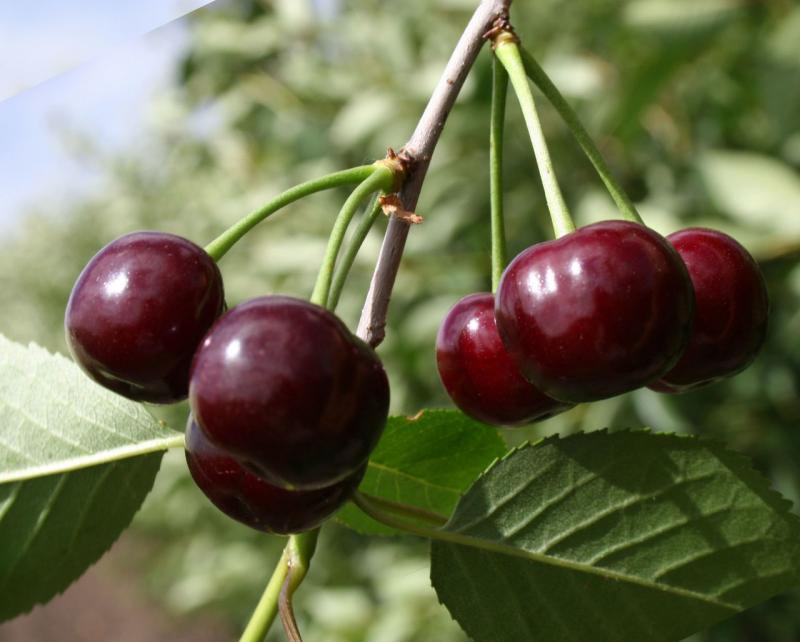

Cherry "Morozovka" has a high yield
The early-growing cherry variety gives the first berries after 3 years. Its yield is above average, more than 200 g of berries can be harvested from a young tree.
In sea buckthorn, one male plant is enough for 8 females, in actinidia colomict - one male for 4-5 females.
Cherries also have self-fertile varieties - for example
A suitable pollinator (and more than one) can grow in an adjacent area, and it is not necessary to plant it on your own.
The cherries are pruned immediately after planting, shortening the branches by about a third. The next 6-7 years, pruning is carried out for the correct formation of the crown, on which our future harvest directly depends. It is best to cut the branches in the spring, immediately after the buds begin to spill out, when you can see which shoots have suffered in winter, and which ones have remained alive, but before they begin to swell completely.
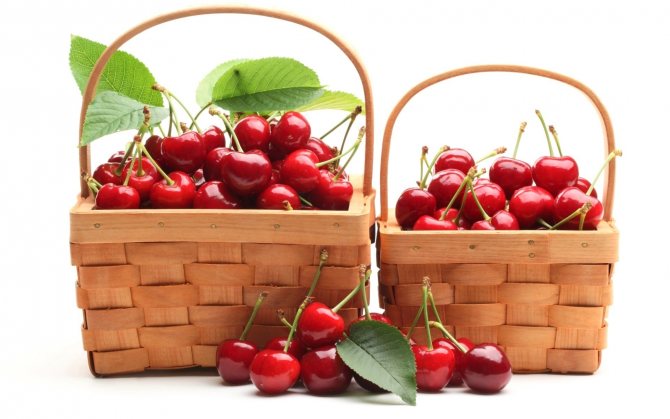

Cherries love the sun and are afraid of the wind, so for growing them it is best to choose gentle slopes, preferably south, southwest or west. They like to grow along the southern side of fences: there is enough sun, less wind, and more snow, which means it is more humid.
By the way of pollination, cherries can be as
Self-fertile varieties
If you garden in a region with severe winters, then the seedlings purchased in the fall, if they did not have time to be planted before frost, it is better to dig horizontally for winter storage, sprinkle with a thick layer of soil or mulch, and subsequently with snow, and plant in spring.
At its core, the variety is versatile, even fairly mature trees, with proper care, can yield about 25-30 kg of berries per season. This is despite being self-fertile, which implies pollination with the help of others.Cross-pollinated trees bear fruit, regardless of weather conditions, they need one more, or better, several pollinating seedlings. The necessary helpers are sometimes immediately sold together in order to avoid non-yield, confusing the type of trees.
The seedlings harvested in the fall are planted in the spring. Soils for them are chosen non-acidic sandy, sandy loam or loam.

